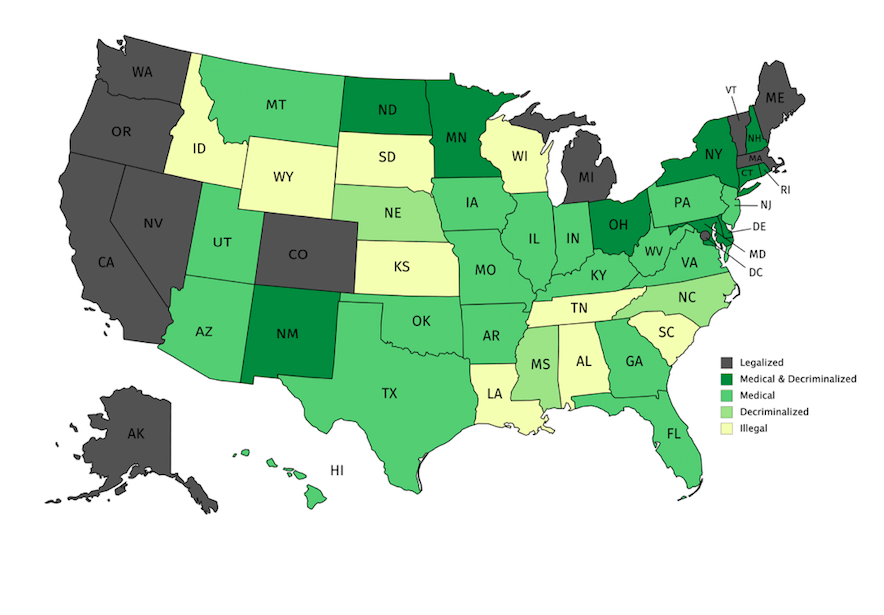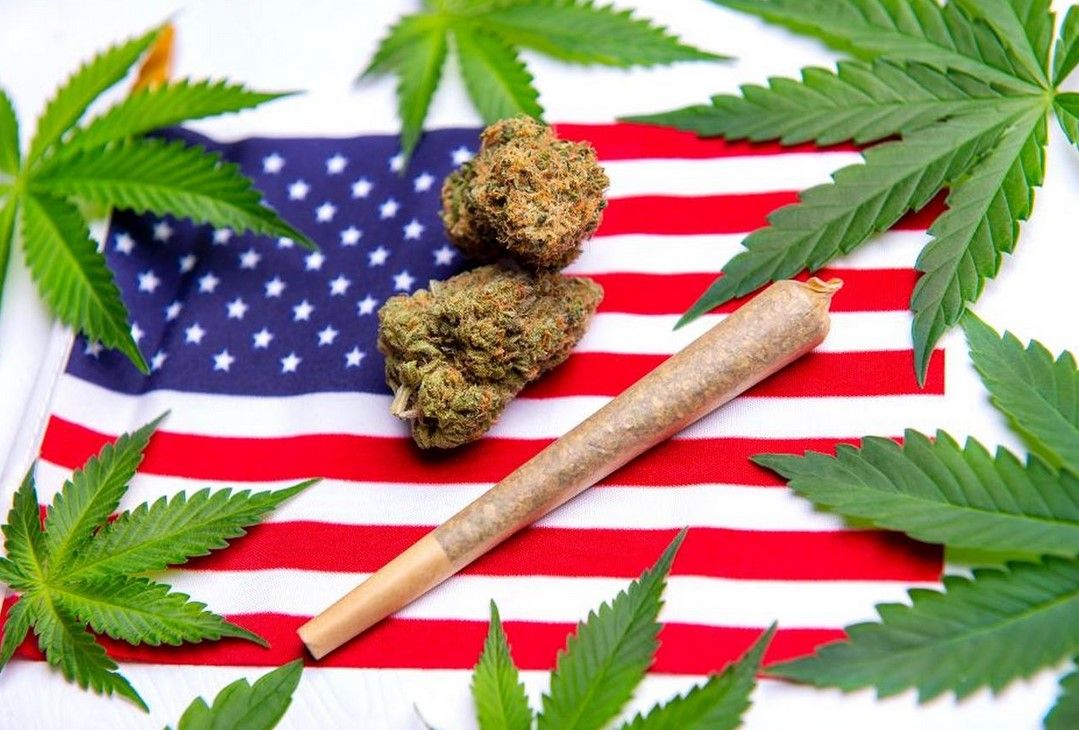In 1937, the United States government made cannabis illegal under federal law. The legislation was created by the Federal Bureau of Narcotics (FBN) with help from its commissioner, Harry Anslinger. The FBN’s initial focus was to stop opium and heroin smuggling, but it also played a role in criminalizing weed through the Marijuana Tax Act of 1937.
Anslinger’s accomplishments were mainly drug-related. He was very pleased to see a high number of arrests and imprisonments for using cannabis among people of color. With its international power, America convinced other countries to adopt its anti-marijuana views.
It has been more than 80 years since the Marijuana Tax Act, and only Canada and Uruguay currently allow adult-use of weed.
Several other countries allow medical marijuana, and it is legal in 33 states plus D.C. Even though it hasn’t received federal approval, millions of people around the world say that using pot has given them medical benefits.. Prohibition of the plant has made research more difficult, but there are still thousands of studies that suggest cannabis isn’t as harmful as some people believe.
We provide five reasons why medical marijuana should be allowed in all fifty states.
Marijuana Prohibition Is an Utter Failure
The National Prohibition Act, also known as the Volstead Act, enforced the 18th Amendment which aimed to prohibit alcoholic beverages in America. It was ratified in January 1919 during a time where America tried to maintain a more Puritan lifestyle. The outcome of this act turned out to be disastrous.
After the 18th Amendment was passed, criminal gangs took control of the black market alcohol industry. In the 1920s, large city streets were paved with blood due to figures such as Al Capone. The 21st Amendment repealed the 18th in 1933, though some states still kept prohibition laws. There are even dry counties today.
The government took almost 15 years to realize its mistake with alcohol, and over 80 years later, it still hasn’t budged on the marijuana issue. Despite the enormous cost to law enforcement with little return on investment, in 2018 police officers made around 663,000 cannabis-related arrests. 92% of these were simply for possession of the substance.
Each year, police forces across the country waste billions of dollars enforcing possession laws for small amounts of weed. This not only does nothing to stop the black market cannabis trade, but it also ruins lives by giving people with small amounts of weed criminal records.
Then there is the small matter of racial discrimination in enforcing these laws. African-Americans are almost four times more likely to get arrested for cannabis crime than white Americans. These days, white Americans use it at a higher rate!
Legalized Marijuana Is Safer
Legalizing cannabis has been shown to have a negative impact on crime rates, according to research By Farley and Orchowsky. The data used for this study comes from 11 states where researchers looked at both qualitative and quantitative information in order answer the following questions:
- In states where cannabis is legal for recreational purposes, how does this impact criminal justice resources?
- How do legal cannabis locations affect states neighboring them in terms of criminal justice resources?
- How does legalization affect drug trafficking rates in northwest border states?
The researchers found that cannabis legalization doesn’t have a large, positive or negative effect on legal states or the states surrounding them. There is data that even suggests crime rates slightly decreased in legalized states!
In 2001, Portugal took a major step in their fight against drugs when they decriminalized possession and use of all drugs. This did not lead to an increase in drug usage as many had predicted, but instead resulted in a decrease!
It is difficult to understand why the American authorities continue to prohibit cannabis use, despite an increasing number of states legalizing it. The black market for weed dwarfs the legal one, and changing that will take several years. For example, data from BDS Analytics and ArcView Market Research suggests that California’s legal market won’t outsell its illicit one until 2024.
Consequently, criminal gangs will continue to thrive by selling marijuana at a lower price than licensed dispensaries. However, the quality of black market pot is often poor and without regulatory testing like legal dispensaries have to go through. In fact, the recent vaping illness epidemic emerged from using cannabis oil sourced illegally . Those living in states where MMJ is still illegal must resort to taking risks to access it.

Several ‘Legal’ Drugs Are More Harmful
The widely accepted cannabis myth of our generation is the Gateway Theory. The belief is that marijuana leads to trying harder drugs, like heroin. However, there are dozens of studies disproving this theory. According to the Controlled Substances Act, weed categorizes as a Schedule I substance because of its high potential for addiction; yet another actree SUPPORTING THE GATEWAY THEORY).
Once again, reality is very different. Indeed, Dr. Sanjay Gupta, CNN’s chief medical correspondent, says that weed is less addictive than tobacco. Approximately 9-10% of marijuana users develop a harmful dependence on the substance, compared to 30% of tobacco users. An estimated 29% of opioid users misuse the drugs.
In the United States, more than 45,000 people die from an overdose that is opioid-related annually. Tragically, this number has become normalized in our society. We must do better. 88,000 Americans die as a result of alcohol-related diseases every year and 480,000 from smoking cigarettes. It’s easy for any American adult to purchase cigarettes or alcohol despite these alarming statistics. Too often physicians prescribe opioids without proper care or evaluation .
Compared to other drugs, cannabis is much safer. In fact, it would be impossible to overdose on marijuana in the traditional sense. You would need to consume at least 20,000 joints in around 15 minutes to die from the toxicity level. Of course, individuals with mental illnesses that suffer paranoid delusions should avoid cannabis altogether.
Even though more research is needed, evidence currently available points to the conclusion that for most people, MMJ is safer than tobacco, alcohol, or opioids.
Cannabis Taxation Brings in Revenue
The cannabis industry has given states that have legalized the plant a significant financial boost from taxes. States usually tax cannabis in one of three ways: By percentage of the price, weight or potency. And although consumers aren’t exactly thrilled about paying these taxes, it’s another positive point for those who are pro-cannabis.
When Colorado surpassed $1 billion in cannabis state revenue in June 2019, it more than doubled its figures from less than two years earlier. The state raked in substantial tax income, with monthly earnings never dipping below $20 million between July 2017 and reaching the billion-dollar mark. In addition to various other programs, money from sales of weed goes towards youth drug-prevention services and mental health support.
In 2019, Marijuana sales tax exceeded 1.9 billion dollars across the United States–a 33% increase from 2018 numbers. The state of California topped the charts with 629 million in weed-derived taxes while Washington followed closely behind at 512 million, partially due to their high tax rate.
Even though legalizing marijuana would financially help local and state governments, there is one main obstacle: Congress. If marijuana was to be legalized, businesses who sell cannabis are subject to Section 280E of the U.S Tax Code because Schedule I substances are still federally illegal.
If the government legalizes MMJ, weed businesses would no longer be required to pay taxes. It is estimated that the loss of tax revenue from Section 280E would cost the federal government $5 billion in ten years.
Marijuana Helps People
Last but certainly not least, for centuries cannabis has been used as a form of medicine. Unfortunately, because it is illegal in many places research surrounding it is sparse. Even though the federal government has not approved its use, they have allowed Big Pharma companies to create medicines containing hemp and cannabis cannabinoids.
Although cannabis has not been proven to undeniably cure any medical condition, there are multiple studies that suggest cannabis could help alleviate symptoms associated with various conditions. These include depression, anxiety, chronic pain and more.
According to a study done by Chan, Burkhardt, and Flyr and published in Economic Inquiry in 2019, it is suggested that MMJ actually aids people who are trying to wean themselves off opioids. The research data found that cannabis legalization can reduce opioid deaths by up 35% annually.
Final Thoughts
The people who try to keep cannabis illegal do not have your best interests in heart. Most of claims about the negative aspects of MMJ are easy to disprove with evidence. But, it seems unlikely that cannabis will become fully legalised in America anytime soon.
Federal legalization of weed is unlikely to happen in the near future because Republicans control the Senate until at least January 2021. However, things might change once Mexico legalizes adult-use marijuana in a few years since America would be surrounded by countries with legal cannabis then.

